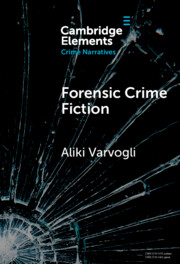Select Bibliography
Auden, W. H. ‘The guilty vicarage’, in The Dyer’s Hand and Other Essays (London: Faber and Faber, 1975), pp. 146–58.
Bell, S. Crime and Circumstance: Investigating the History of Forensic Science (Westport, CT: Praeger, 2008).
Belling, C. ‘Reading the operation: Television, realism, and the possession of medical knowledge’, Literature and Medicine, 17.1 (1998), 1–23.
Bergman, K. ‘Fictional death and scientific truth: The truth-value of science in contemporary forensic crime fiction’, Clues: A Journal of Detection, 30.1 (Spring 2012), 88–98.
Chou, J. ‘Seeing bones speaking: The female gaze and the posthuman embodiment in Reichs’s forensic crime fiction’, Concentric: Literary and Cultural Studies, 38.1 (March 2012), 145–69.
Close, G. S. Female Corpses in Crime Fiction: A Transatlantic Perspective (London: Palgrave, 2018).
Cornwell, P. Body of Evidence (London: Warner, 1991).
Cornwell, P. Point of Origin (London: Warner, 1998).
Cornwell, P. Postmortem (London: Warner, 1990).
Foster, N. ‘Strong poison: Chemistry in the works of Dorothy L. Sayers’, in Gerber, S. M. (ed.), Chemistry and Crime: From Sherlock Holmes to Today’s Courtroom (Washington, DC: American Chemical Society, 1983), pp. 17–29.
Gerritsen, T. The Sinner (London: Penguin, 2023).
Gerritsen, T. The Surgeon (London: Ballantine Books, 2001).
Goulet, A. ‘Crime fiction and modern science’, in Allan, J., Gulddal, J., King, S., and Pepper, A. (eds.), The Routledge Companion to Crime Fiction (London: Routledge, 2020), pp. 291–300.
Horsley, K. and L. ‘Body language: Reading the corpse in forensic crime fiction’, Paradoxa, 20 (2006), 1–30.
Howell, K. ‘The suspicious figure of the female forensic pathologist investigator in crime fiction’, M/C Journal, 15.1 (2012). https://doi.org/10.5204/mcj.454. Jermyn, D. ‘Labs and slabs: Television crime drama and the quest for forensic realism’, Studies in History and Philosophy of Biological and Biomedical Sciences, 44 (2013), 103–9.
Kenley, N. ‘Global crime, forensic detective fiction, and the continuum of containment’, Canadian Review of Comparative Literature, 46 (2019), 96–114.
Kenley, N. ‘Teaching American detective fiction in the contemporary classroom’, in Beyer, C. (ed.), Teaching Crime Fiction (London: Palgrave Macmillan, 2018), pp. 63–81.
Kennedy, J. G. ‘The limits of reason: Poe’s deluded detectives’, American Literature, 47.2 (1975), 184–96.
Kirby, D. A. ‘Forensic fictions: Science, television production, and modern storytelling’, Studies in History and Philosophy of Biological and Biomedical Sciences, 44 (2013), 92–102.
Knight, S. Form and Ideology in Crime Fiction (Bloomington: Indiana University Press, 1980).
Kobialka, M. ‘Delirium of the flesh: “All the dead voices” in the space of the now’, in Bleeker, M. (ed.), Anatomy Live: Performance and the Operating Theatre (Amsterdam: Amsterdam University Press, 2008) pp. 223–44.
Kristeva, J. The Powers of Horror: An Essay on Abjection, trans. L. S. Roudiez (New York: Columbia University Press, 1984).
Lucas, R. ‘Anxiety and its antidotes: Patricia Cornwell and the forensic body’, Literature Interpretation Theory, 15.2 (2010), 207–22.
Murley, J. The Rise of True Crime: 20th-Century Murder and American Popular Culture (Westport, CT: Praeger, 2008).
Palmer, J. ‘Tracing bodies: Gender, genre, and forensic detective fiction’, South Central Review, 18.3/4 (Autumn–Winter 2001), 54–71.
Pâquet, L. ‘Kathy Reichs’s Contiki crime: Investigating global feminisms’, Clues 33.1 (2015), 51–61.
Pepper, A. Unwilling Executioner: Crime Fiction and the State (Oxford: Oxford University Press, 2016).
Plain, G. ‘From “the purest literature we have” to “a spirit grown corrupt”: Embracing corruption in twentieth-century crime fiction’, Critical Survey, 20.1 (2008), 3–16.
Plain, G. Twentieth-Century Crime Fiction: Gender, Sexuality and the Body (Edinburgh: Edinburgh University Press, 2001).
Poe, E. A. The Complete Tales and Poems of Edgar Allan Poe (London: Penguin, 1982).
Reichs, K. Death du Jour (London: Arrow Books, 2000).
Reichs, K. Déjà Dead (London: Arrow Books, 1997).
Ross Nickerson, C. ‘Introduction: The satisfactions of murder’, in Nickerson, C. Ross (ed.), The Cambridge Companion to American Crime Fiction (Cambridge: Cambridge University Press, 2010), pp. 1–4.
Sawday, J. The Body Emblazoned: Dissection and the Human Body in Renaissance Culture (London: Routledge, 1995).
Shepherd, R. Unnatural Causes (London: Penguin, 2019).
Steenberg, L. Forensic Science in Contemporary American Popular Culture: Gender, Crime, and Science (London: Routledge, 2013).
Strengell, H. ‘“My knife is so nice and sharp I want to get to work right away if I get a chance”: Identification between author and serial killer in Patricia Cornwell’s Kay Scarpetta Series’, Studies in Popular Culture, 27 (October 2004), 73–90.
Thomas, R. R. Detective Fiction and the Rise of Forensic Science (Cambridge: Cambridge University Press, 1999).
Todorov, T. The Poetics of Prose, trans. Richard Howard (London: Cornell University Press, 1977).
Vanacker, S. ‘Warshawski, V. I., Kinsey, Millhone and Scarpetta, Kay : Creating a feminist detective hero’, in Messent, P. B. (ed.), Criminal Proceedings: The Contemporary American Crime Novel (London: Pluto Press, 1997), p. 62–77.
Wahrig, B. ‘“Nature is lopsided”: Muscarine as scientific and literary fascinosum in Dorothy L. Sayers’ The Documents in the Case’, in Klippel, H., Wahrig, B., & Zechner, A. (eds.), Poison and Poisoning in Science, Fiction and Cinema, Palgrave Studies in Science and Popular Culture (Cham: Palgrave Macmillan, 2017), pp. 57–73.



